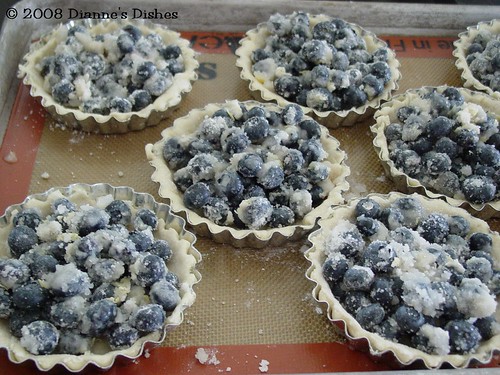
BASIC PIE FILLING by
If you use apples, make sure you pre cook a bit in the oven, enough to be fork tender
avoid runny pies: Most fruit pies involve mixing the fruit with sugar, cornstarch, etc. and letting sit in a bowl for 15-30 minutes before baking. After this point, leave the juice that comes off the fruit in the bowl. It’s just more water that will have to bake off for you to get a solid pie. This sugar bowl period is a way of engineering some of the moisture to leave the fruit ahead of time so it doesn’t have to bake as long.
Ingredients
about 4 cups fruit
4 Tbs sugar
2 Tsb potato starch ( the ratio is 1Tbsp x 2 cups of fruit )
2 Tsb butter
seasoning and flavorings as you like, blueberry goes well with lavender
Instructions
mix everything together and toss into mini pies ! Pile the fruit into the centre of the pie – a domed pie looks more professional.
To make the crust, choose the cherry pie recipe
All fruit, peaches, apples, cherries – anything larger than a blueberry pretty much – needs to be chopped up well enough that when it’s cooking in a big pile, it’s actually structurally sound. For cherries, this means cut in half or better. For apples, you’re going to want 1/8 to 1/4-inch thick slices. Peaches, rhubarb and strawberries should be similar. Then, make sure that you’re placing them in the pie so that they are lying flat against one another. And then, over-fill. It WILL sink, but if you stack everything an inch taller than you think you need, it will settle right where you want it. To avoid the gap between filling and top crust, make sure to work and roll the crust very little using rice flour to avoid a tough dough, which will stay high while the fruit goes flat. Also cook 1/2 of the fruit for few minutes, chill before filling and freeze the pie before baking
Yes, this will probably mean that your pie will bubble over if you’ve got a lattice top crust ( I recommend always using for fruit pies). In my opinion, bubbling over is an inevitable part of making a good pie. To make sure that doesn’t make a huge mess of your oven, place the pie on a baking sheet lined with aluminum foil.
The easiest way to stop burning edges is, the moment you notice the outside of the crust getting brown faster than the center, cover it with foil. Take a square of foil large enough to cover the pie pan. Fold in half, then in half again, and cut around the edge to make a circle, paper snowflake style. unfold to make a foil cover that protects the edges but lets the center show through. You can add this at any time during the cooking process but I do not recommend using from the beginning.
To make the crust, choose the cherry pie recipe
All fruit, peaches, apples, cherries – anything larger than a blueberry pretty much – needs to be chopped up well enough that when it’s cooking in a big pile, it’s actually structurally sound. For cherries, this means cut in half or better. For apples, you’re going to want 1/8 to 1/4-inch thick slices. Peaches, rhubarb and strawberries should be similar. Then, make sure that you’re placing them in the pie so that they are lying flat against one another. And then, over-fill. It WILL sink, but if you stack everything an inch taller than you think you need, it will settle right where you want it. To avoid the gap between filling and top crust, make sure to work and roll the crust very little using rice flour to avoid a tough dough, which will stay high while the fruit goes flat. Also cook 1/2 of the fruit for few minutes, chill before filling and freeze the pie before baking
Yes, this will probably mean that your pie will bubble over if you’ve got a lattice top crust ( I recommend always using for fruit pies). In my opinion, bubbling over is an inevitable part of making a good pie. To make sure that doesn’t make a huge mess of your oven, place the pie on a baking sheet lined with aluminum foil.
The easiest way to stop burning edges is, the moment you notice the outside of the crust getting brown faster than the center, cover it with foil. Take a square of foil large enough to cover the pie pan. Fold in half, then in half again, and cut around the edge to make a circle, paper snowflake style. unfold to make a foil cover that protects the edges but lets the center show through. You can add this at any time during the cooking process but I do not recommend using from the beginning.